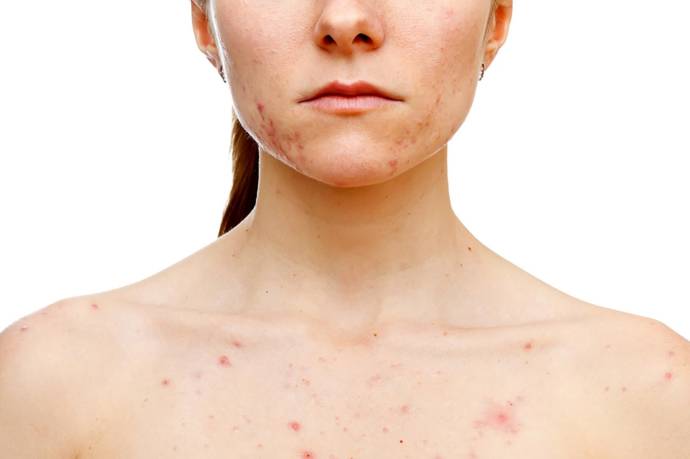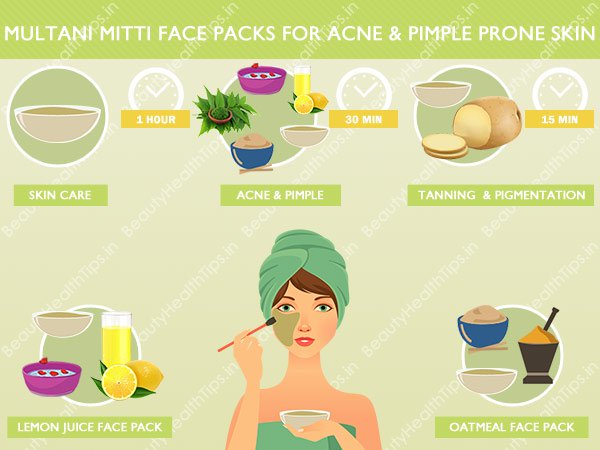Acne is usually caused by clogged pores or follicles due to excessive secretion of sebum, and dead skin cells. Chest acne or pimples on chest is a common problem, and people who are involved in activities which cause them to sweat a lot suffer from acne on the chest. While acne on chest isn’t usually visible to everyone it may cause blemishes, and is a nuisance to deal with, especially during summer when you want to show some skin. Luckily getting rid of acne redness or pimple rash isn’t such a nuisance.
Remedies for pimple or acne redness on chest
Herbal or essential oils
Essential oils have either antibacterial or antiseptic properties. Simply add ten drops of essential oil such as, peppermint, tea tree, calendula, lavender, etc. to an ounce of any carrier oil such as olive, primrose, hazelnut, almond, sunflower, grape seed, etc. Apply onto the affected area gently. Always test for sensitivity. In 8 ounces of water add a drop of the essential oil, dab a bit of it onto the skin, and wait for an hour. Use it only if there is no reaction.
Cleanser
Cleansers with salicylic acid are effective against acne since they have shedding agents. Gently exfoliate the skin with an exfoliating glove and the cleanser. Exfoliating the skin rids it of all the dead cells. Do not use the glove for more than a few months since the glove becomes a breeding ground for bacteria after prolonged use. Also, one mustn’t exfoliate too roughly since it may increase the inflammation and redness; it also tends to dry out the skin.
Apple cider vinegar
Apple cider vinegar contains antibacterial and antiseptic components which reduce acne redness, and treat acne as well. Make a natural toner with equal part apple cider vinegar and equal part water. Apply the tone all over the affected area, and do not rinse it off. The toner keeps well for weeks if stored well in a cool and dry place. Do not forget to shake the bottle containing the toner well before use.
Aloe vera
Aloe vera gel contains antiseptic and antibacterial components which not only reduce inflammation and redness but it also heals the acne. The aloe gel can be either store-bought, or naturally procured. In case you happen to have an aloe vera plant nearby chop-off a sliver, remove the outer green skin from one side with a knife, and scoop out the gel.
Salt-bath
Run a hot bath, and a cup of sea salt into the tub. Soak the affected area into the bath. Salt helps to clean the pores and reduces the growth of acne causing bacteria. In case it is difficult to try the sea salt-bath treatment, one may only opt for salt compress. Dip a soft piece of cloth into a cup of warm water mixed with three tablespoons of sea salt. Place it over the affected area for a couple of minutes, and then rinse. One may also add a few drops of essential oil into both the salt bath and the salt compress water.
Topical “zit zapper”
These creams contain 0.5-2% concentration of salicylic acid which acts as a shedding agent, and curbs acne. Smearing the cream onto the acne affected area reduces the redness and inflammation, as the cream tends to dry out the acne very quickly.
Aspirin
This medicine works magic on acne. Add two crushed aspirin into a teaspoon of water, and one teaspoon of honey. Mix well and apply over the acne. Aspirin also contains salicylic acid, while honey has natural antibiotic properties. Together they not only reduce inflammation and redness, they also heal the acne quickly.
Cinnamon and honey
These two can be combined to form a potent herbal acne-cure. Cinnamon contains antimicrobial properties, while honey helps fighting the acne causing bacteria. Make a paste with a teaspoon of cinnamon with two teaspoons of honey. Apply it as a mask over the acne affected area. Rinse it off after 30 minutes.
Benzoyl peroxide
Over-the-counter lotions or creams containing benzoyl peroxide fight the acne causing bacteria. They also dry out the skin, and remove the dead-skin cells.





